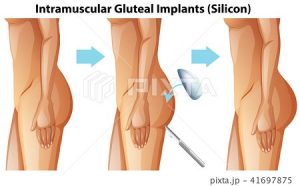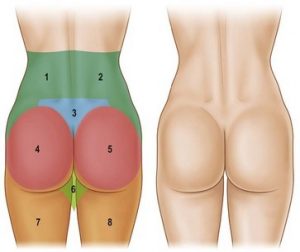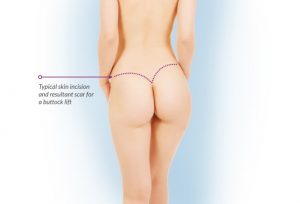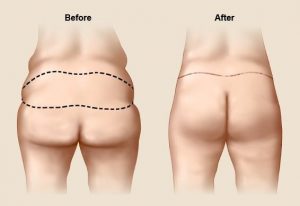Gluteal Augmentation Buttock Augmentation

Introduction,
A special thanks goes to Nicki Minaj and the Kardashian family. I don’t think I have ever performed a buttock augmentation without a patient referring to them either in affirmation or vito.
Buttock augmentation is one of the fasted growing procedures in plastic surgery, seeing an annual increase of over 30%. The features associated with an attractive booty are age and culture specific. Reshaping does not only involve increasing or decreasing the size of the buttocks but also involves reshaping the surrounding areas. It is impossible to have an attractive buttocks without an appropriate waist, lateral curvatures and inferior buttock folds.
There are at least 5 different techniques to shape and define the buttocks. The most commonly used procedures are implant placement, fat transfer or a buttock lift using your own tissues. I get the best result with a combination of the fat transfer and an implants.
It is important to realise that buttock augmentation comes with a considerable severe risks not seen in other plastic surgical procedures. Thus many a plastic surgeon will be reluctant to perform this operation. It is important that you are fully aware of the risks and complications described below.
Another important consideration is to make sure I understand your desires. It holds true that beauty resides in the eye of the beholder. Below follows illustrations be sure to indicate to me what exactly you are looking for. Fullness may be achieved in different areas. Perhaps you desire central projection without much consideration for the outer post parts or vice versa. Together we will decide which appearance is most suited for you and decide on an appropriate surgical action.

 Buttock Augmentation using a Silicone Implant
Buttock Augmentation using a Silicone Implant
Just as we use silicone implants to increase our breasts size, so may we use silicone implants to augment the gluteal area. We use specific silicone implants of a flatter and wider projection than those used in breast augmentation.
The procedure is done under sedation or general anaesthesia depending on the duration and extend of the operation .Two parallel incisions are made on either side of the midline of each buttocks. The length of the incision is directly proportional to the area that is being augmented and the size of the implant. The implant is placed in the muscles of the buttock so as to give adequate cover and prevent visibility. The implants are closed in a layered fashion over a drain in each buttock
The results of the buttock augmentation is visible immediately. Over time the swelling will subsides and the incisions will fade. Swelling may persist for up to three months after the procedure.
After the operation you should wear a compression garment for 3-6 weeks. The drains will be removed after a week and I would have to see you once a week until all the wounds are healed.
Initially will be uncomfortable to sit and sleep. I recommend that you try sleep on your tummy or sides. Sitting on the implants will be uncomfortable but is allowed. Person hygiene is of utmost importance.
Buttock implants carry the risk of scarring, excessive bleeding, and becoming dislodged. The main concerns with buttock implants are infection and wound separation. The incision used is in the gluteal cleft near the anus, the risk of bacterial infection is higher than with any other cosmetic procedure. Thus it is very important to keep the incision clean and visit us once a week at the dressing clinic.
The incisions for a buttock implant is under stress because you use the muscles and other structures of the buttocks in almost everything you do. Walking, moving and sitting will put a great deal of stress on the implants and the incisions. Although you will be resting a great deal after your surgery, you will still need to move about and walk gently after your surgery. You are allowed to sit using a soft pillow for the first two to three weeks. You should also put a pillow behind your hamstring muscles to provide further support.
There is a chance that one or both of the implants may be dislodged. If the implants are dislodged, they will have to be removed and replaced surgically.
Silicone implants will have to be replaced after a number of years. No one can predict the need for replacement. It is important to have a clinical examination once a year to assess the integrity of the implants.
As with all foreign material they carry the risk of capsular contracture. Your body forms a capsule around a foreign body in order to protect your immune system from the object. With time or in some people due to inherent immune stimulation this capsule may become hard. There are different grades of capsular contractures. Grade one and two are not problematic. Grade three is liked by some patients as it lends firmness. Grade four is associated with pain, discomfort, coldness and anatomical distortion. Once you have formed one capsular contracture the risk of a subsequent capsular contracture is about 80%, mostly due to immune system stimulation.
Infection, wound separation, implant displacement and capsular contractures are the greatest risks associated with buttock implants.
Having said all of this patients love the instant results of an implant.
Buttock Augmentation using Fat Grafting
Fat grafting is a procedure in which fat is removed from one area of the body and transferred to another. The fat is harvested by liposuction in an area of unwanted or excess fat e.g. the belly, love handles, thighs or lower back. It is then process via special techniques and carefully injected into an area where the main aim is correct a volume deficit.
Volume replacement and correction of contour deformities are all possible with fat transfer. In buttock augmentation fat transfer is the only reliable way in which to augment the lateral aspect of the buttocks. The fat harvesting via liposuction allows me to shape the surrounding areas, lower back, saddle bags and upper thighs in order to further create an attractive buttocks.
Recent literature suggest that fat has numerous added advantages. Fat is rich in pro-inflammatory cytokines, growth factors, and stem cells and has a multiple cellular functions. Thus the benefits of fat stretches far beyond what the naked eye may see. Often we see an improved skin texture in the area where fat grafting was done.
Usually, 40% of the injected fat cells may not survive, thus additional fat grafting may be required several months later. However the 60 -70% of the fat transplants that do survive will be permanent. It is not uncommon for a patient to receive multiple fat grafting procedures. If you gain or lose weight you will clearly see the difference in the areas where fat transfer were done. Thus it is important to have the procedure when you are as close as possible to your ideal body weight. Don’t worry about not being able to find fat, for some reason I am always able to find some. Wink.
Fat transfer is performed under sedation or general anaesthesia depending on the size of the area being treated. You will be able to go home the same day.
The procedure may take anything from 30 minutes to 2 hours depending on the amount of fat to be removed, the areas treated and additional procedures performed.
Small 5 mm cuts are made to pass a cannulas with which the fat will be removed. Fluid may be infiltrated first to assist the fat removal. It is this fluid that may drain or leak after the procedure for 24 to 72 hours, this in completely normal. Once the fat has been removed and the desired contour achieved the small cuts are closed with a stich which will be removed 7 to 10 days later.
You will be strapped with compressive dressing or placed in compressive garments after the procedure. These dressings or garments should be worn continuously for 4 to 6 weeks except when showering as the garments will assist the contraction process.
Liposuction is associated with a fair amount of swelling and bruising which may persist for 4 to 6 weeks. You will experience moderated pain, tingling, burning and numbness in the area that was treated. The numbness may be permanent. The initial pain and swelling is surprising but with improve quickly.
During the first two weeks it is important not to apply sustained pressure to the buttocks. Pressure will cause death of the transferred fat and either cause loss of volume or the formation of fat necrosis. Fat necrosis is the way in which fat cells scar. The lumps which may be permanent and in rare cases painful.
It is better to sleep on your tummy or on your side for as long as possible. It is unknown as to how long the newly transferred fat cells will take to ensure sustained survival. Much like planting a pot plant. Certainly care has to be taken during the first 4 weeks. I would recommend that you do not sit for long periods of time during the first 4 weeks.
The biggest risk associated with gluteal fat transfer is the possibility of developing a fat embolism which may lead to death. In the buttock area there are multiple large blood vessels. If a fat globule enters one of these blood vessels the fat globule may spread to the lungs which may cause death. The incidence of pulmonary fat embolism is low but it remains a risk and is well described in the literature.
Other complications may be asymmetries, irregularities, prolonged swelling and pain. Reoperation may also be needed if the fat cells do not survive. The exact causes for failure of survival of the fat cells are unknown. Pressure and smoking certainly affects it negatively and for some reason a high metabolic rate contributes.
I get really good results with gluteal fat transfer and liposuction of the surrounding areas. It is important to be fully aware of the risk and complications.
The Buttock Lift
A buttock lift is a cosmetic procedure to improve the appearance of the buttocks. In massive weight loss patients, lower body rejuvenation is needed. Here we perform a lower body lift or belt lipectomy to contour the buttocks, groin, thighs and abdomen.
During the buttock lift, excess skin and fat are removed from the buttocks. The remaining skin is repositioned to create a more toned look.
You may choose to have a buttock lift if your buttocks appear saggy due to weight loss, aging or genetics. As you get older, your skin changes and becomes looser due to the loss of elastin and collagen resulting in skin sagging. The buttock lift addresses this problem .The buttock lift cannot change the quality of the skin but can certainly improve the shape.
The procedure is done under general anaesthesia. I would recommend that to stay in hospital for one night but it may be done s a day procedure. The incisions are done in area just above your buttocks. In some cases depending on the deformity I may also make an incision below the buttock.


 After the procedure there will be suction drains in the buttocks to remove any fluid accumulation or bleeding. The drains will be removed after a week. I will have to see you once a week until all the wounds are healed. The biggest risk associated with this procedure is wound infection due to proximity to the anus and wound separation due to infection or due to strain from movement.
After the procedure there will be suction drains in the buttocks to remove any fluid accumulation or bleeding. The drains will be removed after a week. I will have to see you once a week until all the wounds are healed. The biggest risk associated with this procedure is wound infection due to proximity to the anus and wound separation due to infection or due to strain from movement.
The risk of butt lift include scarring and excessive bleeding. Because the incision is slightly above your buttocks, there is less risk of infection than that seen with the usual incision used for a buttock implant. However, this incision will still be under a great deal of stress as you move. Movement need to be slow and gradual and sleeping on the tummy or sides, I would recommend 3 weeks off work.
Other complications associated with a buttock lift are fluid accumulation below the skin (seroma), poor wound healing, scarring and skin sensation changes with permanent numbness at the operated areas.
Buttock lift results are usually long lasting. Keep in mind that maintaining a stable weight is crucial for retaining your results.

